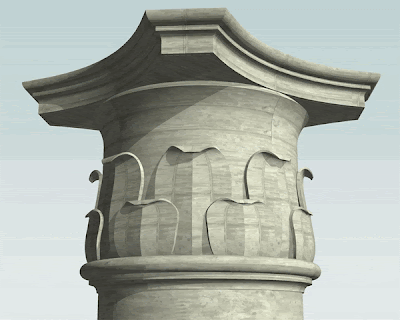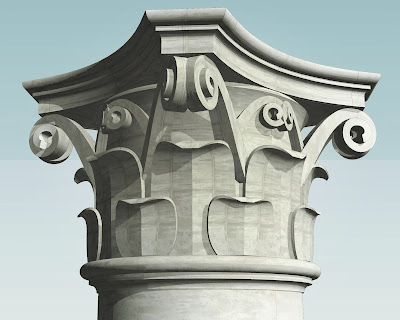I've got quite a nice thing going with Paul Aubin here, motivating each other to think more deeply about what we are doing & to extend our modelling horizons. On the face of it, the topic is classical orders, & more specifically Corinthian Capitals, but as Paul has noted it takes us into various topics of very general application such as appropriate "Level of Detail" (also called Level of Development or LOD)
In my previous post, I imagined a number of different scenarios that might suggest rather different approaches to these issues, depending on what you wanted to achieve & the method of procurement (eg "off the shelve components" versus "project specific design & install by approved specialist") Paul has taken a slightly different approach. basically setting himself a very demanding modelling challenge and seeing how close he can get. It's a work in progress but the results to date are impressive to say the least
The work I want to show in this post was inspired by Paul's efforts and was mostly done just before the Pumpkin Competition. It was in fact my first attempt at a "scalable rectangular rig" and helped to give me the confidence to tackle a scalable vegetable collection.
So I had recently watched Paul's video clip and having recovered from the initial shock, suddenly got the idea that a 2 dimensional rig could be used to create a leaf. I made it adaptive so that it could be repeated around a cylindrical form.
I decided to keep the profile simple also, for the initial "proof of concept" stage at least. So it's a triangle with flattened ends, which was easy to set up parametrically.
I made 3 different types, and hosted 4 instances on to the spline. The "mid" type is used twice. The sizes of these 3 profiles are linked to parameters in the host file so that you end up which can be made broader or narrower after you load it. So there are triangular profiles, nested into a leaf, which is nested into a corinthian capital, and from the capital file you can adjust the size of those triangles to control the proportions of the leaves.
Within the capital file, the adaptive leaf components are hung onto a cylinder which has height and radius parameters. This gives me a circular array of 8 leaves with the controls I need.
Double up the ring and you are well on your way to a Corinthian Capital.
Before I set about the scrolls at the corners, I needed an abacus to push them up against. I conceptualised this as an extrusion with a sweep running around the edge and set about making a scalable rig for the sketch defining the extrusion. This worked out fine as shown above.
If you look over my previous post you will note that the proportions of corinthian capitals can vary quite a bit. This is quite easy to do with the controls I built into the leaf family. At this stage I compared my capital with the photos and decided that I had the S curve of the leaf wrong. Not that there is an absolute "right" & "wrong" here, but I wanted to capture the way that most of the leave in my photos went up straighter and curled out more at the top.
This just meant opening up the leaf family and adjusting the spline. Enough of that. Time to tackle the spiral scrolls. Once more I turned to a rectangular rig. This time it's a square with a cross, and then a union jack in the top right corner.
Draw a spline and host a few rectangular profiles along it. Create form & play with the sizes & proportions of these rectangles. Watch out for self-intersecting geometry. The first attempt is going to be too open and rather uneven, but you can zoom in there and nudge each point around to close up the gaps.
There may well be better ways to make these scrolls, but this one is quite interesting and I managed to tighten up the gaps quite nicely. Then it was just a matter of linking all the profile sizes back to parameters and controlling these by formulas containing "X" (where X & Y are the sides of the whole rig) Now the whole thing will scale up and down by typing in a new X value. Good enough
So I plugged in 16 copies of the scroll (8 big & 8 small) and decided to call it a day. Each of the elements that make up the capital is separately scalable, but as yet I can't scale the whole thing up and down with a single click. Also it is still a somewhat stylised and simplified version. Currently it is standing at almost 6mb. Not disastrous, but you things might slow down a bit if you had a couple of hundred of them (think Colloseum)
This was all done almost 6 weeks ago, just before I launched myself into the vegetable kingdom. You can expect an update shortly, and keep an eye on Paul's blog also to see how his version develops.
http://paulaubin.com/
In my previous post, I imagined a number of different scenarios that might suggest rather different approaches to these issues, depending on what you wanted to achieve & the method of procurement (eg "off the shelve components" versus "project specific design & install by approved specialist") Paul has taken a slightly different approach. basically setting himself a very demanding modelling challenge and seeing how close he can get. It's a work in progress but the results to date are impressive to say the least
The work I want to show in this post was inspired by Paul's efforts and was mostly done just before the Pumpkin Competition. It was in fact my first attempt at a "scalable rectangular rig" and helped to give me the confidence to tackle a scalable vegetable collection.
So I had recently watched Paul's video clip and having recovered from the initial shock, suddenly got the idea that a 2 dimensional rig could be used to create a leaf. I made it adaptive so that it could be repeated around a cylindrical form.
I decided to keep the profile simple also, for the initial "proof of concept" stage at least. So it's a triangle with flattened ends, which was easy to set up parametrically.
I made 3 different types, and hosted 4 instances on to the spline. The "mid" type is used twice. The sizes of these 3 profiles are linked to parameters in the host file so that you end up which can be made broader or narrower after you load it. So there are triangular profiles, nested into a leaf, which is nested into a corinthian capital, and from the capital file you can adjust the size of those triangles to control the proportions of the leaves.
Within the capital file, the adaptive leaf components are hung onto a cylinder which has height and radius parameters. This gives me a circular array of 8 leaves with the controls I need.
Double up the ring and you are well on your way to a Corinthian Capital.
Before I set about the scrolls at the corners, I needed an abacus to push them up against. I conceptualised this as an extrusion with a sweep running around the edge and set about making a scalable rig for the sketch defining the extrusion. This worked out fine as shown above.
If you look over my previous post you will note that the proportions of corinthian capitals can vary quite a bit. This is quite easy to do with the controls I built into the leaf family. At this stage I compared my capital with the photos and decided that I had the S curve of the leaf wrong. Not that there is an absolute "right" & "wrong" here, but I wanted to capture the way that most of the leave in my photos went up straighter and curled out more at the top.
This just meant opening up the leaf family and adjusting the spline. Enough of that. Time to tackle the spiral scrolls. Once more I turned to a rectangular rig. This time it's a square with a cross, and then a union jack in the top right corner.
Draw a spline and host a few rectangular profiles along it. Create form & play with the sizes & proportions of these rectangles. Watch out for self-intersecting geometry. The first attempt is going to be too open and rather uneven, but you can zoom in there and nudge each point around to close up the gaps.
There may well be better ways to make these scrolls, but this one is quite interesting and I managed to tighten up the gaps quite nicely. Then it was just a matter of linking all the profile sizes back to parameters and controlling these by formulas containing "X" (where X & Y are the sides of the whole rig) Now the whole thing will scale up and down by typing in a new X value. Good enough
So I plugged in 16 copies of the scroll (8 big & 8 small) and decided to call it a day. Each of the elements that make up the capital is separately scalable, but as yet I can't scale the whole thing up and down with a single click. Also it is still a somewhat stylised and simplified version. Currently it is standing at almost 6mb. Not disastrous, but you things might slow down a bit if you had a couple of hundred of them (think Colloseum)
This was all done almost 6 weeks ago, just before I launched myself into the vegetable kingdom. You can expect an update shortly, and keep an eye on Paul's blog also to see how his version develops.
http://paulaubin.com/














No comments:
Post a Comment
I've been getting a lot of spam so had to tighten up comments permissions. Sorry for any inconvenience. I do like to hear from real people